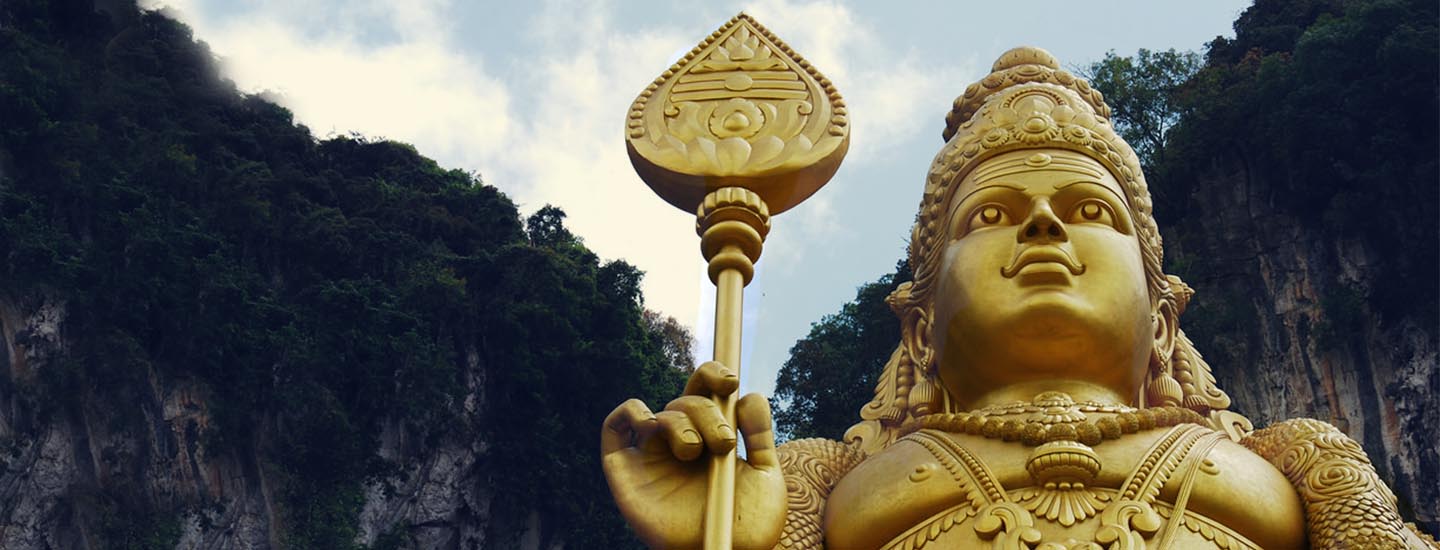In many ways Lord Kartikeya is a mysterious god. In North India he has been virtually forgotten and there are no temples dedicated to this son of Lord Shiva. In the east he is remembered once a year during Kartik Puja. Then during Durga Puja he stands beside Devi Durga with Saraswati, Lakshmi and Ganesh as they present the perfect portrait of a divine family. In the east too he is not as important as his generous brother Ganesh.
It is in South India, especially in Tamil Nadu that Kartikeya has risen to a powerful
presence that matches the popularity of Ganesh. Here he is Murugan, divine, handsome, ever youthful and the greatest of the warrior gods. He is wise and knowledgeable as Subramaniam.
Also he is Skanda, the great son of Shiva and Parvati and sits with them in many sculptures. One thing is certain, Kartikeya-Murugan is very handsome god and in the east he is depicted as an eternal bachelor. He is always riding off to war on his peacock, carrying his spear, bow and arrow. In the early eras of Hindu mythology it was Lord Indra who was the commander-in- chief of the army of the devas but by the time of the Skanda Purana, Kartikeya had taken his place. It is young Kartikeya who marches out with the deva army when the asuras invade the heaven or Swarga. Many mythological stories talk of Indra being defeated by the asuras but Kartikeya always reigns supreme on the battlefield.
South India, especially Tamil Nadu and in regions where Tamils have settled, like Sri
Lanka, Singapore and Malaysia, Murugan is worshipped widely. During the festival of Thai Pusam, celebrated in the Tamil month of Thai, during the first full moon after Pongal Sankranti colourful processions are taken out and some devotees even pierce their bodies as a form of worship.
The worship of Murugan is so popular that across Tamil Nadu there are six sacred
temples called Arupadaiveedu or the Six Abodes of Murugan. These temples are located at:
- Swamimalai in Kumbakonam
- Palani in Dindigul.
- Thiruchenedur in Toothukudi.
- Thirupparam Kunram in Madurai.
- Thiruthani in Thiruvallur.
- Pazhamidurcholai in Madurai.
Kartikeya’s greatest enemies are the asuras who signify all the negative characters of living creatures – anger, greed, envy, violence and hatred. Hinduism does not have a satan, devil or demons that are all evil. Asuras and rakshasas can also have good qualities like Ravana was a great scholar and a devotee of Shiva and his brother Vibhishan was a moral person. Similarly King Bahubali was a popular king who worshipped Vishnu and even today he is remembered in Kerala during Onam. So Kartikeya’s battles against the asuras reflect our own struggle against hatred, violence and ignorance.
Kartikeya may be a bachelor in Bengal but in the south his adoring devotees have gifted him with two wives. One is Devasena, the daughter of Indra and the other is Valli, the beautiful daughter of a tribal king. At times he is depicted with six heads as he was created from the heat of Shiva’s third eye. Even the fire god Agni could not hold the heat in his hand and he poured it into the Ganga River. Here the drops landed on six lotus blossoms and six baby boys appeared there. The six stars called Krittikas nurtured the boys and when they grew up they were merged into one god by Parvati. As the Krittikas had brought him up, the god was named Kartikeya.
The month of Kartik (September / October) is the most sacred month of the Hindu calendar. First there is Pitri Paksha when we worship our ancestors. It is followed by the joyous Dussehra as we celebrate Ram’s victory over Ravan. At the same time the east sways to the drum roll of the Durga Puja as the warrior goddess once again kills Mahisha the asura. It all happens in the month named after Kartikeya.
The symbol of the triumph of good over evil, an epitome of courage and grace, Kartikeya- Murugan is a god who is easy to love and worship.


